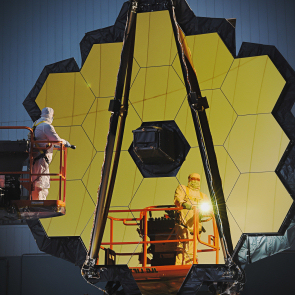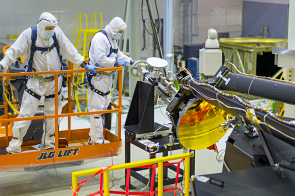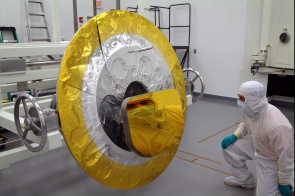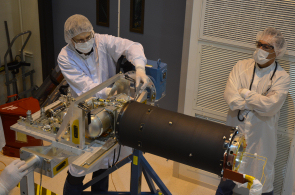#10: The observatory is assembled
21 December 2016
With less than two years remaining before its scheduled launch, the James Webb Space Telescope (JWST) has passed several major milestones, including the completion of its huge primary mirror and integration of its four science instruments with the payload module.| Time-lapse: The assembly of the JWST primary mirror. Click here for more details and video downloads.Credit: NASA's Goddard Space Flight Center |
The first milestone was reached in February 2016, with the completion of the 6.5 metre diameter primary mirror, the largest mirror structure ever designed to fly in space. The 18th and final hexagonal segment, which measures 1.3 metres across, was moved into position on the telescope structure using a specially developed robotic arm.
In order to fit inside the protective fairing of the Ariane 5 launch vehicle, the primary mirror is installed on a structure that folds up like a drop-leaf table. Once JWST begins its operational mission in space, all the primary mirror segments can be moved and their curvature changed to make sure that they act like a single, giant mirror.
 |
| Inspecting JWST's primary mirror. Credit: NASA–C. Gunn |
At this stage, all of the primary mirror segments were wearing a protective cover to keep them clean and prevent any damage to their meticulously shaped, gold-coated surfaces. The primary mirror only appeared in its full splendour in May when the covers were removed.
A few weeks later, the single secondary mirror was installed onto the telescope at NASA's Goddard Space Flight Center (GSFC) in Greenbelt, Maryland. The convex mirror is perfectly rounded and designed to reflect light arriving from the primary mirror towards another set of smaller mirrors.
The observatory's optics were completed on 6 March 2016, when the third set of mirrors – the tertiary mirror and the fine steering mirror – were installed. These two mirrors were located inside the Aft Optics Subsystem (AOS), a phone booth-sized beryllium structure which is located in the centre of the primary mirror.
 |
 |
| JWST's secondary mirror installed. Credit: NASA–C. Gunn |
JWST's gold-coated tertiary mirror. Credit: Ben Gallagher (Ball Aerospace) and Quantum Coating Incorporated. |
After incoming light hits the primary mirror, it is directed onto the smaller, circular secondary mirror, which reflects it back in the direction of the primary mirror and into the AOS. At the rear of the AOS is the tertiary mirror, which sends the light beam forward to the fine steering mirror at the front of the AOS. The light is finally reflected out of the back of the AOS to a focus behind the primary mirror for the scientific instruments.
By this stage, the cryogenic testing of the observatory's Integrated Science Instrument Module (ISIM) and the attached science instruments had been completed. (See footnote)
After nearly four months of testing and monitoring in temperatures of 40 degrees Kelvin (minus 233 degrees Celsius), the ISIM was removed from the Space Environment Simulator (SES), a huge thermal vacuum chamber at Goddard Space Flight Center in Greenbelt, Maryland.
The SES duplicated the vacuum and extreme temperatures that JWST must survive in order to fulfil its mission to explore the Universe. Vacuum pumps were used to remove almost all of the air from the giant cylindrical chamber, while liquid nitrogen and gaseous helium caused the temperature to plummet toward absolute zero.
| Installation of JWST's science instruments. Click here for more details and video downloads. Credit: NASA's Goddard Space Flight Center |
In May, the ISIM was lowered with surgical precision into the telescope structure. Inside the world's largest cleanroom at GSFC, a crane lifted the science instrument package, lowered it into an enclosure on the back of the telescope, and secured it in place.
During this impressive operation, it was necessary to flip the telescope over and fold the struts supporting JWST's secondary mirror. As a result, the telescope was pointing toward the floor, rather than the ceiling, of the giant cleanroom.
 |
| Inspecting the MIRI cryocooler. Credit: NASA/JPL-Caltech |
May also saw a unique cooler developed for MIRI complete a long period of intensive testing at NASA's Jet Propulsion Laboratory in Pasadena, California. This cryocooler is essential to lower the temperature of the mid-infrared detectors on MIRI to 7 K (minus 266 degrees C).
Its main portion, called the cryocooler compressor assembly, was shipped on 26 May to its next destination, the Northrop Grumman Aerospace Systems facility in Redondo Beach, California. There, the cooler will eventually be united with the MIRI instrument itself and the rest of the JWST spacecraft.
The integration of the combined Optical Telescope element / Integrated Science instrument module (OTIS) was completed in the summer by installing the electronic boxes and a set of radiators that will be used to dissipate the heat generated by the instruments and their electronics once JWST is in space.
Footnote
The science payloads tested were:
- the Mid-Infrared Instrument (MIRI), jointly developed by a nationally funded European Consortium under the auspices of ESA and the NASA Jet Propulsion Laboratory;
- the Near-InfraRed Spectrograph (NIRSpec), developed by Airbus Defence and Space GmbH for ESA, with key contributions by NASA Goddard Spaceflight Centre;
- the Fine Guidance Sensor / Near-InfraRed Imager and Slitless Spectrograph, provided by the Canadian Space Agency and developed by Honeywell (formerly COM DEV International) of Cambridge, Ontario, Canada;
- the Near-InfraRed Camera (NIRCam), built by a team at the University of Arizona and Lockheed Martin's Advanced Technology Center.
About JWST
The James Webb Space Telescope (JWST) will be a general-purpose observatory with a 6.5-metre telescope optimised for infrared observations and a suite of four astronomical instruments capable of addressing many of the outstanding issues in astronomy. The primary aim is to examine the first light in the Universe – those objects which formed shortly after the Big Bang. Further aims include: looking at how galaxies form; the birth of stars; and the search for protoplanetary systems and the origin of life, including the study of exoplanets. JWST is a joint project of NASA, ESA and the Canadian Space Agency. It is scheduled for launch in 2018 on an Ariane 5 and will operate approximately 1.5 million kilometres from the Earth in an orbit around the second Lagrange point of the Sun-Earth system, L2.






